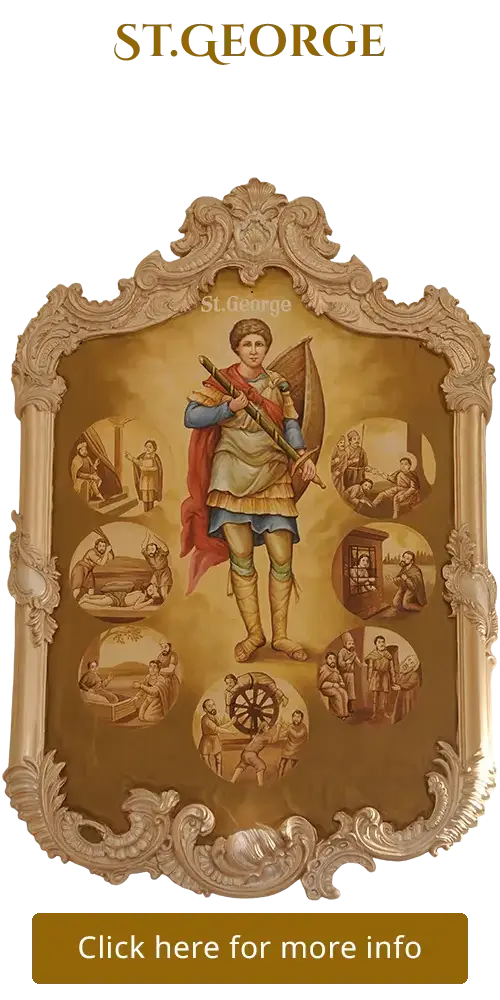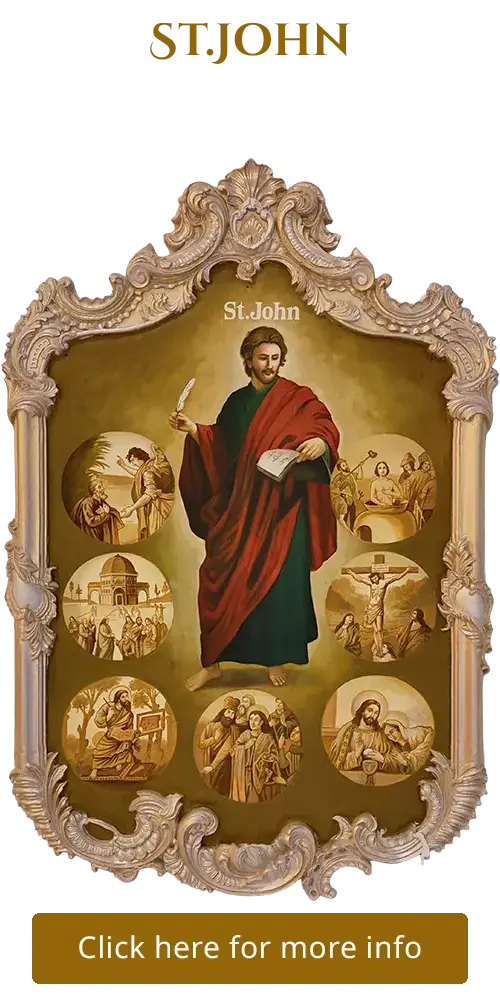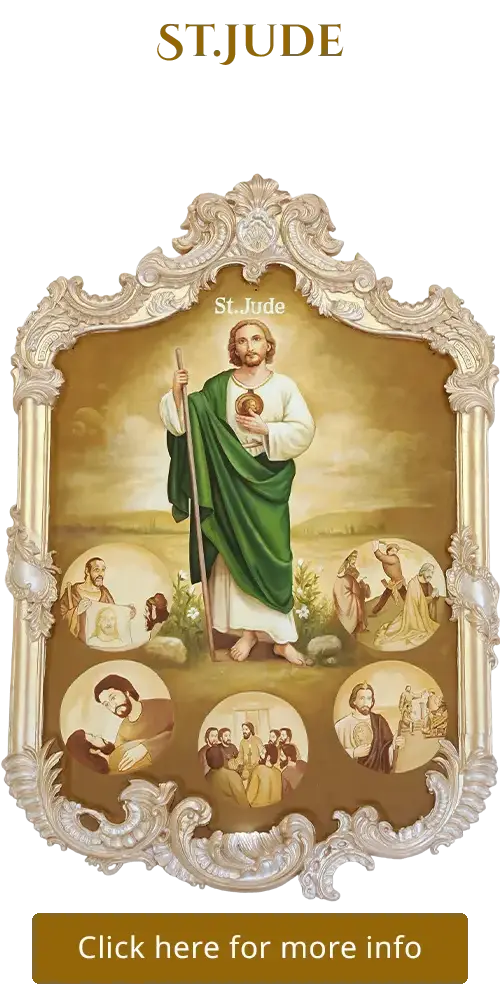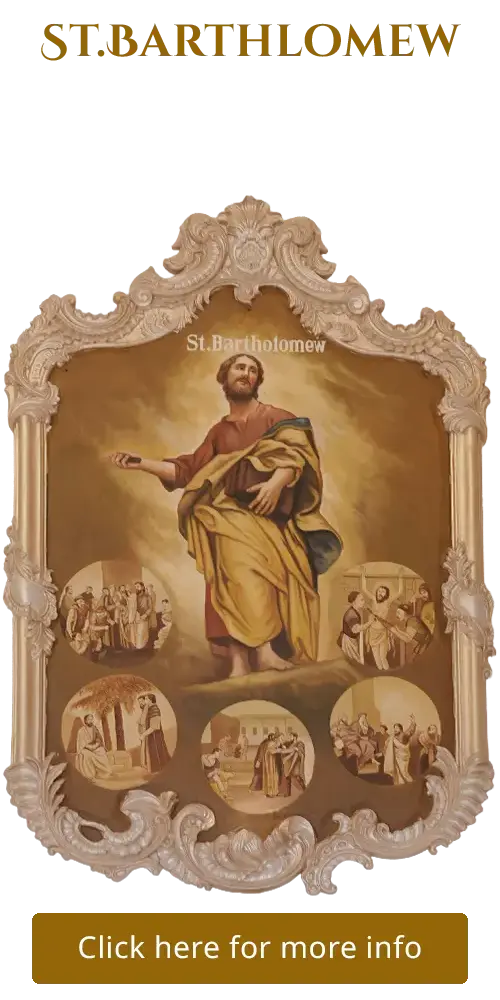St. John
Inside Paintings - South Wall
St. John
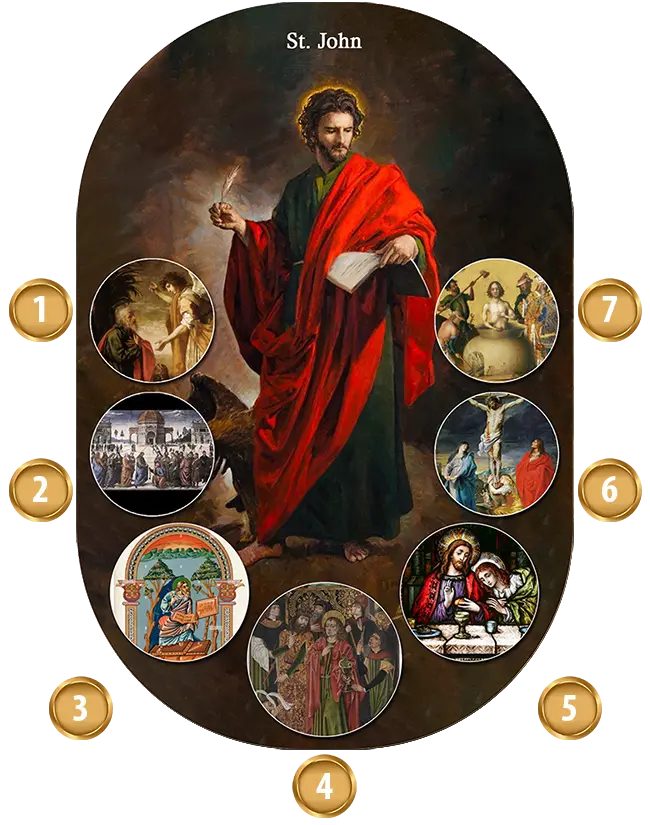


1. St. John on Patmos Receiving Revelation
Biblical Reference: Revelation 1:10-11
Description: Around 95 AD, the Apostle John, one of Jesus’ closest disciples, was exiled to the island of Patmos (Greece) by the Roman Emperor Domitian. This banishment came as a result of John’s steadfast preaching of the Christian faith, which conflicted with Roman authorities. On this small, rocky island in the Aegean Sea, John, then in his later years, found himself isolated from the early Christian communities he had nurtured. It was during this time of exile that, according to tradition, John experienced a series of divine visions. One Sunday, while in prayer, he heard a voice like a trumpet instructing him to write down what he saw. These revelations, recorded in the Book of Revelation, detailed his visions of Christ in glory, messages to the seven churches, and prophetic scenes of the end times, which he faithfully documented despite his circumstances.
2. Witness of Handing of the Keys
Biblical Reference: Matthew 16:19
Description: Jesus told Peter, “I will give you the keys of the kingdom of heaven, and whatever you bind on earth shall be bound in heaven, and whatever you loose on earth shall be loosed in heaven”. In Jewish tradition, “binding” meant to declare something forbidden or to prohibit it, while “loosing” meant to declare something permitted or to allow it. Jesus extended this authority to his disciples, particularly Peter, in the context of the coming church.
John is portrayed with a prayerful demeanor, positioned near Peter, reflecting his close relationship with Christ and his role as a faithful witness. Tradition holds that John, known as the Beloved Disciple, was present during key moments of Jesus’ ministry, and this scene underscores his participation in the foundation of the Church. His presence symbolizes the unity of the apostles in receiving and spreading Christ’s teachings. Though the keys are given to Peter, John’s role highlights his support and the collective mission of the disciples to carry forward the Gospel, linking this event to his later writings and exile on Patmos.
3. Author of New Testament Books
Biblical Reference: John 1:14; John 4:8; John 11:1-44; Revelation 1:9
Description: St. John the Apostle, known as the Beloved Disciple, holds a revered place as the author of several key New Testament writings. Tradition credits him with the Gospel of John, composed toward the end of the first century, around 90-100 AD, after his exile on the island of Patmos. This Gospel offers a deep, spiritual portrayal of Jesus’ life, emphasizing His divinity as the Word made flesh (John 1:14) and including unique accounts like the raising of Lazarus (John 11:1-44). John also wrote three epistles – 1 John, 2 John, and 3 John – which focus on love, truth, and community life among early Christians, with the famous declaration, “God is love” (1 John 4:8).
Additionally, John is recognized as the author of the Book of Revelation, written during his exile on Patmos under Roman persecution around 95 AD (Revelation 1:9). This apocalyptic work, filled with visions of Christ’s return and the new heaven, reflects his prophetic role. Living to an old age in Ephesus, John’s writings, shaped by his close relationship with Jesus, have guided the Church for centuries. For our community, his authorship inspires us to embrace his message of love, faith, and hope, drawing strength from his inspired words.
4. Poisoned Cup
Historical Reference: Earlier Church tradition and hagiographies, such as the Golden Legend by Jacobus de Voragine
Description: In the early days of Christian persecution under Roman rule, St. John the Apostle faced a dramatic test of his faith. Tradition holds that while ministering in Ephesus, John was brought before a Roman governor who sought to silence his bold preaching of the Gospel. To challenge his trust in Christ, the governor ordered John to drink from a cup filled with poisoned wine, a deadly trial meant to prove the weakness of his beliefs. The gathered crowd watched in tense silence as John, unafraid, took the cup in his hands. With a prayer to God for strength, he drank the contents fully.
In an astonishing miracle, St. John suffered no harm. The poison had no effect, and he stood unharmed before the astonished onlookers. This act of divine protection led many to marvel at the power of the God he served, resulting in numerous conversions that day. The event became a powerful testimony to John’s faith and God’s safeguarding presence, reinforcing his mission as the Beloved Disciple even amidst persecution.
5. Beloved Disciple
Biblical Reference: John 13:23-25
Description: Known as the disciple “whom Jesus loved,” John is depicted reclining next to Jesus, resting his head on His chest during this sacred meal. This intimate moment unfolded as Jesus shared His final teachings with the apostles before His crucifixion, including the institution of the Eucharist (Matthew 26:26-28). When Jesus hinted at His betrayer, John, at Peter’s request, leaned in to ask who it might be (John 13:24-25), revealing his close bond with both Christ and the other disciples.
This special relationship is further emphasized throughout John’s life. As the disciple “whom Jesus loved,” his unique bond with Christ is also seen at the foot of the Cross, where he was entrusted with the care of Mary, the Mother of God (John 19:26-27). Called from his life as a fisherman (Matthew 4:21-22), John joined Jesus’ innermost circle with Peter and James, witnessing sacred moments like the Transfiguration (Matthew 17:1-8) and the agony in Gethsemane (Mark 14:33). This title reflects not an exclusive love but John’s receptivity to Christ’s love, which he shared through his writings. His Gospel and epistles, emphasizing love as the heart of Christian life (1 John 4:7-8), along with his long service, including his exile on Patmos, testify to this devotion.
6. At the Crucifixion of Jesus
Biblical Reference: John 19:25-27
Description: John was the only one of Jesus’s twelve close disciples to remain at the crucifixion site on Golgotha. While the other apostles abandoned Jesus and fled after his arrest, John remained steadfastly present, demonstrating unique loyalty.
Jesus entrusted the care of His mother, Mary, to John, saying, “Woman, here is your son,” and to John, “Here is your mother.” John then took Mary into his home, fulfilling Jesus’ dying wish to provide for his mother. Mary remained with John, offering counsel and spiritual strength to the early Church, and according to tradition, she accompanied him to places like Ephesus, Turkey, until her death or Assumption into Heaven.
7. Plunged into boiling oil
Historical Reference: Early Christian tradition and writings
Description: Early Christian writer Tertullian, who lived in the 2nd century, states that during the persecution of Christians under Roman Emperor Domitian, St. John was thrown into a vat of boiling oil but miraculously emerged unharmed, appearing rejuvenated. John only continued to preach from within the pot. He was then exiled to the island of Patmos (Greece).
John survived all of this because God had not finished with him yet. A “revelation” still had to come.
Two years after John’s exile, the emperor Domitian died, and John returned to the church in Ephesus. He lived to an advanced age and he was spared a violent death, a sign of God’s special care for him. Some accounts suggest he was taken into a cave or tomb alive, with the earth above his resting place later found to emit a fragrant oil, symbolizing his sanctity.

